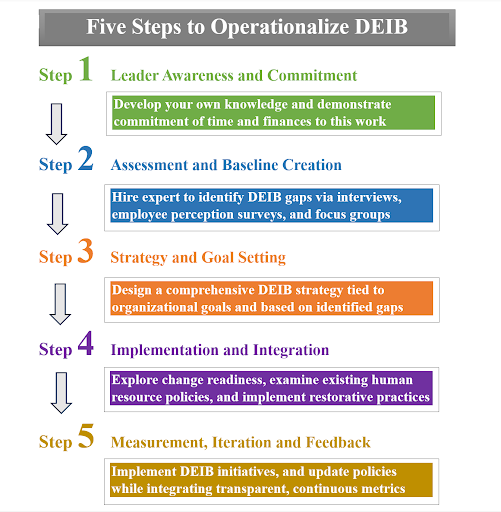In the wake of the U.S. Supreme Court’s dismantling of race-based affirmative action in higher education admission, many organizational leaders are fighting an instinctive knee-jerk reaction to quickly scale back their diversity, equity, inclusion and belonging related processes, KPIs and investments. DEIB and its practitioners face social, budgetary, legislative and legal headwinds. This has led numerous businesses to forgo the verbal and financial commitments they prevalently espoused in 2020 following the murder of George Floyd.
We strongly encourage organizations to refrain from embracing the notion of DEIB as an unsuccessful endeavor. Transformational leaders are seeing the opportunity to show both their employees and their customers that their DEIB efforts are more than just transactional. These leaders are embracing the body of research that demonstrates the positive impact of diversity on business growth over that of homogenous or monocultural organizations. In fact, sixty-six percent of employees believe that organizations are more effective in decision-making when there is a diverse workforce.
Additionally, 82 percent of employees express a sense of being valued by their organization and feel more at ease expressing diverse viewpoints during meetings. As a result, organizations that achieve the top quartile for race and ethnic diversity are 35 percent more likely to achieve earnings above the national average. And, for every 10 percent increase in diversity at the senior leadership level, organizations achieve almost a one percent increase in earnings before interest and taxes. There are many benefits to employees and organizations that continue with their commitment to transformational DEIB work.
A big problem for many businesses that want to get the most out of DEIB is that they make only the bare minimum of commitments or do “aesthetic DEIB” practices without realizing it. These transactional DEIB practices, frequently called DEI-washing, do not result in substantive change to culture or lead to the benefits observed in truly diverse organizations. This is not unlike organizations that talk to their shareholders about changing corporate policy to address profit loss while making no real substantive change to curb corporate spending. In this same way, organizations are grafting DEIB practices onto existing systemic organizational issues that exploit the cultural richness of the organization without creating any fundamental transformation.
How can an organization recognize if they are engaging in aesthetic DEIB practices? They must examine their DEIB cures for those actions that take the form of minimally intrusive methods. Some examples of these minimal methods are having an awareness topic of the month, having an external DEIB guest speaker once in a while, offering voluntary training on unconscious bias and creating employee resource groups with little support. These activities superficially impact organizational culture and provide a veneer of workplace progression without strengthening organizational foundations. While they may be instituted with the best of intentions, this approach results only in DEIB awareness. It does not achieve systemic organizational disruption that will help the organization achieve the strong business growth value of DEIB.
For DEIB to help businesses grow, the way it is defined needs to stop being political. Instead of just looking nice, companies need to switch from transactional DEIB practices to ones that are meaningful, measurable, and directly related to their business goals. Translating DEIB initiatives into a cultural shift that drives concrete organizational actions takes time and effort. The aim is to operationalize DEIB principles in order to effectively influence organizational decision-making and behaviors, ultimately leading to overall success and growth. This article gives leaders a five-step playbook for breaking down the traditional boundaries of DEIB, which are limited to diversity-related jobs, human resources departments, and special awareness days.

Note: An illustration of the five steps in the playbook
Step 1: Leader awareness and commitment
For today’s leaders who want to build more inclusive and equitable organizations, how to institute actual DEIB change is a critical question. The answer is simple: It starts at the top. DEIB transformational success heavily depends on leadership knowledge, commitment and actions. Leaders set the tone for the organization, and their attitudes toward DEIB initiatives can significantly impact their success.
Leadership commitment
Leaders must demonstrate their genuine commitment; otherwise, these initiatives will fail and contribute to the tokenistic culture that undermines these initiatives and often leaves organizations worse off than before they started their DEIB transformation. Genuine commitment involves an investment of both time and financial resources. To begin, leaders must commit their time to actively participate in DEIB change and not simply outsource the effort to human resources or a designated DEIB leader. True change comes from organizational leaders’ everyday behaviors and actions. For those leaders who are unsure what those behaviors and actions should be, the following sections further delineate this information.
Commitment to the DEIB transformation also requires financial backing. Organizations that hesitate to invest in DEIB infrastructure often have leaders who do not see it as a value add to business growth. DEIB investments should be made with a clear understanding of how they contribute value to furthering the organization’s growth strategy. For example, this might bef an investment to implement an inclusive product development process that ensures the new product reaches a broader customer base. Another example might be an investment in diversity recruitment and retention to expand employee diversity to increase organizational innovation. These investments include implementing new policies and processes that ensure inclusive thinking as a standard part of daily operations and provide for the training necessary to enable leaders and employees to embrace this change in thinking.
Once leadership is aware of and committed to a DEIB transformation, its efficacy may be analyzed, like any other business decision, for its ROI. Leaders can leverage the DEIB growth statistics discussed in the following sections or the many other resources available to help establish ROI for their DEIB investments.
Leaders’ own understanding
Organizational leaders must understand and agree DEIB is a crucial component of the organization’s business strategy and critical to its success. As a result, DEIB is viewed at a strategic level in business operations. To help leaders attain this understanding, they must first understand the language and specific business case of DEIB. This should encompass benefits to the business in terms of innovation, reduced employee turnover and increased productivity, as well as how implementing DEIB positively impacts the organization’s customers, products and services.
A DEIB transformational implementation should start by choosing a DEIB leader. This is an important step in developing the in-house level of expertise needed to guide the organization’s DEIB priorities. Unfortunately, organizations usually have many people passionate about DEIB but few, if any, with the required expertise. When searching for a new chief financial officer, organizations would hardly look for employees passionate about stock trading or balancing their checkbooks to fill that role. Similarly, the DEIB function requires years of experience, competency and the ability to apply strategic influence. Leaders must value the complexities of a DEIB leader role and, like all other positions in the organization, find the most experienced and capable person for the job.
Hiring a DEIB leader does not abdicate the leadership team’s responsibility. Leaders must also be aware that those who lead DEIB efforts are often members of marginalized communities, which puts them in the difficult role of patient and prescriber in curing the broad range of DEIB challenges for the organization. Asking those in this function to be the sole purveyors of DEIB change is not dissimilar to those organizations that exhibit poor leadership by expecting HR to be responsible for all of their employees’ performance and feedback. Every leader must be accountable for the DEIB transformation and demonstrate commitment. This frequently starts by creating a culture of open empathy and respect by acknowledging past mistakes and demonstrating commitment to improving future practices.
Leadership education
A successful DEIB transformation requires leaders to take purposeful steps in every interaction and to consider the diversity implications of every situation. Often, leaders do not know where to start or how to assess DEIB in their daily interactions. In order to address this, it is essential that leaders engage with experts to educate themselves about DEIB. Deciding what education is needed depends on the organization’s leaders, but typically begins by assessing current DEIB competencies. Several different leader assessments can aid leaders in this step. For example, Korn Ferry’s Inclusive Leader Assessment focuses on five disciplines: emotional resilience, self-assurance, flexibility, inquisitiveness, and authenticity. DDI outlines seven leadership behaviors that drive inclusion. The Intercultural Development Inventory assesses five core behaviors that result in a leader’s intercultural mindset.
Once leaders understand their baseline competency, learning and development can begin. An educational program that emphasizes inclusion, belonging and accountability will provide a solid foundation for all leaders. This can be an external program or involve hiring subject-matter experts to provide internal training.
Inclusive leadership coaching, in particular, can be immensely valuable for leaders in any organization. Such coaching aims to broaden the understanding of diversity, inclusion and cultural competence. Specific benefits of this coaching include enhanced DEIB self-awareness and a heightened ability to self-reflect. It also improves communication skills through understanding cultural nuances in verbal and non-verbal communication. This coaching can help leaders learn to differentiate between treating everyone equally, being able to give people what they actually need, and being equitable. Inclusive cultural competence leadership training can provide the toolkit for creating an inclusive environment, making better decisions and ultimately supporting leaders to lead more effectively in today’s diverse and globalized world.
Adaptability training that emphasizes cultural awareness also provides strong benefits for leaders engaging in DEIB transformation. Leaders can learn how to recruit better, onboard and retain a diverse workforce, and facilitate innovation through adaptability.
It is important to note that some leaders may benefit from engaging in this coaching and training privately instead of through a group session. Regardless of the approach, effective DEIB training must provide non-judgmental, safe environments to self-reflect on social conditioning and encourage the rewiring of personal biases.






















